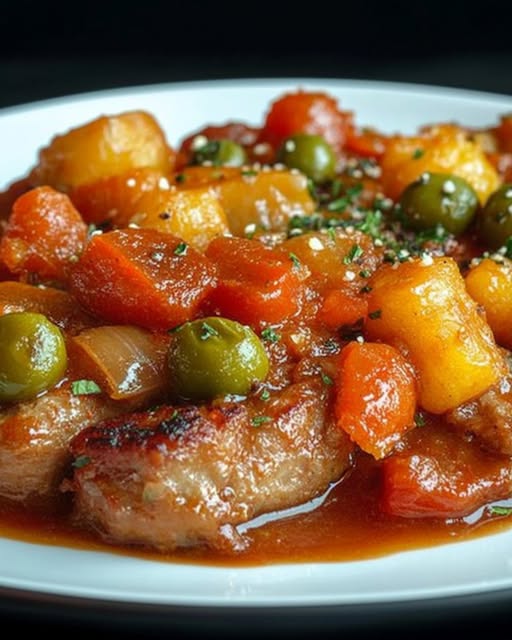Why Chickpea Vegetable Stew is a Game-Changer for Weeknight Dinners
There’s something magical about a hearty bowl of stew, isn’t there? The way it warms your soul and fills your kitchen with mouthwatering aromas. I first made this Chickpea Vegetable Stew on a chilly Sunday evening when my pantry was nearly bare. With just a can of chickpeas, some veggies, and a sprinkle of love, I created a dish that became an instant hit with my family. It’s simple, healthy, and oh-so-satisfying—perfect for anyone who craves comfort food without the guilt.
A Brief Dive into the Roots of Chickpea Vegetable Stew
Stews have been around for centuries, dating back to ancient times when people cooked over open fires. This particular version draws inspiration from Mediterranean and Middle Eastern cuisines, where chickpeas are a staple. Historically, stews were a way to stretch humble ingredients into nourishing meals. Today, this Chickpea Vegetable Stew is a modern twist on tradition, blending fresh produce with pantry staples to create a wholesome dish. I love how versatile it is—it’s as much at home on a busy weeknight as it is at a cozy dinner party.
Why You’ll Fall in Love with This Recipe
First off, it’s packed with flavor. The sweetness of carrots, the earthiness of chickpeas, and the tangy kick of tomatoes come together beautifully. Plus, it’s ridiculously easy to make—even if you’re not a seasoned cook. Another bonus? It’s budget-friendly. You probably already have most of the ingredients in your pantry. And let’s not forget: it’s vegetarian and packed with nutrients. What’s not to love?
Perfect Occasions to Whip Up This Stew
This Chickpea Vegetable Stew is perfect for casual family dinners, potlucks, or even meal prep. I often make a big batch on Sundays and enjoy it throughout the week. It’s also a great dish to bring to a friend who needs a little extra care—a warm meal always says “I’m here for you.” Plus, it pairs beautifully with crusty bread or a side of fluffy rice, making it feel like a complete meal.
Ingredients for a Flavorful Chickpea Vegetable Stew
- 400 g of canned chickpeas
- 1 onion
- 1 garlic clove
- 300 g of zucchini
- 200 g of carrots
- 250 g of potatoes
- 1 tablespoon of olive oil
- 300 g of canned diced tomatoes
- 1 chicken bouillon cube (or vegetable bouillon for a vegan option)
- 250 ml of water
- Salt and pepper to taste
Substitution Options for Flexibility
If you don’t have chickpeas, try lentils or white beans. Swap zucchini for eggplant or green beans if you prefer. For a gluten-free option, ensure your bouillon cube is certified gluten-free. Don’t have fresh garlic? A teaspoon of garlic powder works too. The beauty of this stew lies in its adaptability!
Step 1: Prep Your Ingredients
Start by washing and chopping your veggies. Dice the onions, mince the garlic, and cut the zucchini, carrots, and potatoes into bite-sized pieces. I find this step oddly therapeutic—it’s like giving your ingredients a little spa day before they take a dip in the pot. Pro tip: Keep your knife skills sharp to avoid uneven cooking. Uniform pieces cook faster and look prettier on the plate.
Step 2: Sauté the Aromatics
In a large pot, heat the olive oil over medium heat. Add the onions and garlic, letting them sizzle until fragrant and golden. This step is crucial because it builds the flavor foundation of your stew. Imagine the aroma filling your kitchen—it’s like a warm hug for your nose. Chef’s tip: Don’t rush this part; sautéing slowly brings out the natural sweetness of the onions.
Step 3: Add the Vegetables
Toss in the zucchini, carrots, and potatoes. Stir them around to coat them in the garlicky goodness. Watching the vibrant colors of the veggies mingle in the pot is like creating edible art. Let them cook for a few minutes to soften slightly before moving on to the next step.
Step 4: Incorporate the Tomatoes and Broth
Add the diced tomatoes, water, and bouillon cube. Stir everything together and season with salt and pepper. The liquid should gently bubble, coaxing the flavors to meld. This is where the magic happens—the stew starts to thicken and develop its rich, savory character. Pro tip: Taste as you go and adjust the seasoning to suit your palate.
Step 5: Simmer and Add Chickpeas
Let the stew simmer for about 20 minutes, then stir in the drained chickpeas. Cook for another 10 minutes to let the flavors deepen. The chickpeas add a creamy texture and nutty flavor that ties everything together. By now, your kitchen smells amazing—you might even have neighbors knocking to see what’s cooking!
Step 6: Serve and Enjoy
Spoon the stew into bowls and serve it piping hot. Pair it with steamed rice or crusty bread for a complete meal. Garnish with fresh herbs like parsley or cilantro if you’re feeling fancy. Dig in and savor the comforting flavors. Bon appétit!
Timing Breakdown
- Prep time: 15 minutes
- Cooking time: 30 minutes
- Total time: 45 minutes
Chef’s Secret to Elevate Your Stew
Here’s a little trick I learned: stir in a splash of lemon juice or a dollop of yogurt just before serving. It brightens the flavors and adds a refreshing zing. Trust me, it makes all the difference!
An Interesting Fact About Chickpeas
Did you know chickpeas have been cultivated for over 7,500 years? They’re one of the earliest crops farmed by humans. No wonder they’ve stood the test of time—they’re nutritious, versatile, and downright delicious!
Necessary Equipment
- A large pot or Dutch oven
- A sharp knife and cutting board
- A wooden spoon or spatula
Storage Tips for Leftovers
Store any leftovers in an airtight container in the fridge. This stew tastes even better the next day as the flavors continue to meld. It stays fresh for up to 4 days. For longer storage, freeze portions in freezer-safe containers. Thaw overnight in the fridge before reheating.
When reheating, do so gently on the stove to prevent the vegetables from becoming mushy. Add a splash of water or broth if the stew seems too thick. If freezing, label the containers with the date to keep track of freshness.
Pro tip: Portion the stew into individual servings before freezing. That way, you can grab just what you need without defrosting the entire batch.
Tips and Advice to Perfect Your Stew
- Use fresh vegetables for the best flavor.
- Don’t skip the sautéing step—it boosts the depth of flavor.
- Taste and adjust seasoning frequently.
Presentation Ideas
- Garnish with fresh herbs like parsley or basil.
- Serve in colorful bowls for a pop of visual appeal.
- Drizzle a bit of olive oil on top for a glossy finish.
Healthier Alternative Recipes
1. Low-Sodium Version: Use no-salt-added tomatoes and skip the bouillon cube. Season with herbs like thyme or rosemary instead.
2. Vegan Option: Replace the chicken bouillon with vegetable bouillon and use olive oil generously.
3. Spicy Kick: Add a pinch of red pepper flakes or a dash of cayenne for heat.
4. Creamy Twist: Stir in a spoonful of coconut milk for richness.
5. Grain-Free: Skip the rice and serve with roasted cauliflower or sautéed spinach.
6. Protein Boost: Add tofu or tempeh for extra plant-based protein.
Mistake 1: Overcooking the Vegetables
Overcooking turns veggies mushy and ruins their texture. To avoid this, add delicate veggies like zucchini later in the cooking process. Keep an eye on the pot and taste-test frequently.
Mistake 2: Skipping the Sauté Step
Some folks skip sautéing the onions and garlic to save time, but this step is key to building layers of flavor. Take the extra few minutes—it’s worth it!
Mistake 3: Underseasoning
A bland stew is a sad stew. Always taste as you go and adjust the seasoning. Salt enhances the natural flavors of the ingredients.
Frequently Asked Questions
Can I make this stew ahead of time?
Absolutely! In fact, it tastes better the next day. Store it in the fridge and reheat gently on the stove.
Is this recipe vegan-friendly?
Yes, simply swap the chicken bouillon for a vegetable-based option.
Can I freeze this stew?
Definitely. Freeze in portions and thaw overnight in the fridge before reheating.
How can I make it spicier?
Add chili flakes, cayenne, or a diced jalapeño for a fiery kick.
What can I serve with this stew?
Rice, quinoa, or crusty bread pair beautifully. A side salad works too!
Do I have to use canned chickpeas?
No, you can use dried chickpeas. Just soak and cook them beforehand.
Can I add meat to this stew?
Of course! Chicken or sausage would be delicious additions.
What herbs go well with this dish?
Try thyme, rosemary, or oregano for added depth.
How long does it last in the fridge?
Up to 4 days if stored properly in an airtight container.
Can I use frozen vegetables?
Yes, but add them later in the cooking process to avoid overcooking.
Final Thoughts
This Chickpea Vegetable Stew is more than just a recipe—it’s a celebration of simple, wholesome ingredients coming together to create something truly special. Whether you’re cooking for yourself or sharing it with loved ones, this dish promises warmth, flavor, and satisfaction. So grab your pot, gather your veggies, and let’s get cooking. Your taste buds will thank you!

Chickpea Vegetable Stew
Ingredients
Equipment
Method
- Wash and chop the veggies: dice the onions, mince the garlic, and cut the zucchini, carrots, and potatoes into bite-sized pieces.
- In a large pot, heat the olive oil over medium heat, and sauté the onions and garlic until golden.
- Add zucchini, carrots, and potatoes to the pot and stir for a few minutes to soften.
- Incorporate diced tomatoes, water, and bouillon cube; season with salt and pepper.
- Let the stew simmer for about 20 minutes, then stir in the drained chickpeas, and cook for another 10 minutes.
- Serve hot, garnished with fresh herbs if desired, alongside rice or crusty bread.
